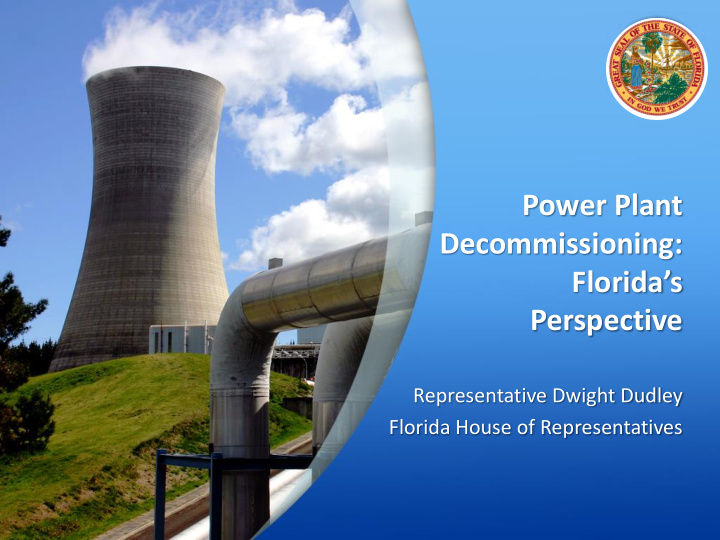



COMPANY OGO Power Plant Decommissioning: Florida’s Perspective Representative Dwight Dudley Florida House of Representatives
• CR3 began operation in 1977 • Cost = $470 million • During construction, a flaw was discovered in the upper dome of the reactor’s concrete containment building. • Steel reinforcement was added to the dome, but not to the walls. • CR3 was deactivated in 1996 due to problems with back-up generators. • Placed on the Nuclear Regulatory Commission’s watch list of the 14 worst-run reactors in the U.S. (out of 109)
• In 2009, CR3 was taken offline so that two of its steam generators could be upgraded. • In an attempt to save $15 million, the utility decided to perform the upgrades themselves. • In the process, a containment wall was damaged. • Efforts to fix the problem made it worse. • Estimated cost of repair = $3.4 billion. • In 2013, Duke Energy announced that the plant would be permanently closed. • CR3 was ultimately retired 27 years earlier than its natural lifespan.
• $1.3 billion for repairs, operations, maintenance and construction • $450 million for uprates under Florida’s Nuclear Cost Recovery statute • As much as $300 million per year for replacement fuel • $1.5 billion for a natural gas plant to replace generation lost from the closure of CR3
• The metro area surrounding crystal river topped the nation in GDP loss in 2014. • 400 plant workers lost their jobs. • Duke Energy’s tax bill dropped from $35 million to $13 million. • 1/4 of the county’s general fund • Dire consequences for schools, safety and public services • “Nuclear stigma”
• Duke collected $100 million from the original failed upgrades to the plant’s steam generators. • In addition, they were able to keep 7% from a subsequent $100 million project to stabilize the broken containment wall. • Granted by Florida’s Public Service Commission
• $1.18 billion in 2013 dollars • ~100 million for a dry cask fuel storage site • Decommissioning fund = $780 million
• CR3 entered safe storage (SAFSTOR) in July of 2015. • One of three decommissioning strategies (DECON, ETOMB) • The process could take up to 60 years. • Duke has estimated that the Decommissioning Trust Fund will grow over that time to cover the cost.
• Require licensees to have adequate decommissioning funds upon closure. • Prohibit funds from being used for purposes other than the cleanup of radiological contamination. • Proactively monitor expenditures. • Ensure that unexpended funds are released to ratepayers.
• Replace the Post-Shutdown Decommissioning Activities Report (PSDAR) with the Decommissioning Plan. • Require licensees to justify selection of SAFSTOR as a decommissioning strategy. • Establish inspections and enforcement during the decommissioning process. • Formalize a fourth method that combines aspects of DECON and SAFSTOR.
• Restore hearing rights of the public. • Establish site-specific advisory boards that allow affected communities to participate in the process. • Permit Agreement States to become involved in decommissioning.
Recommend
More recommend